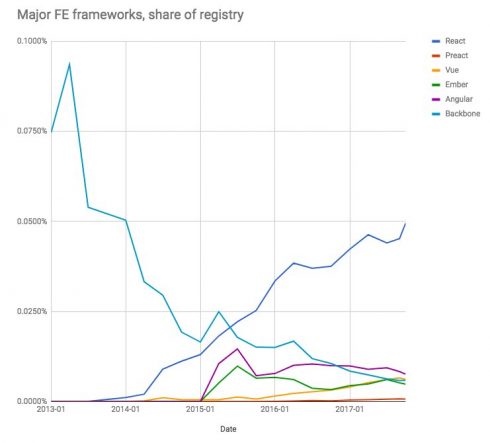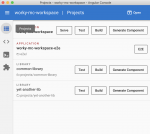
npm has just released the first State of JavaScript report for 2018. The series of reports will offer a complete review of JavaScript development trends and practices.
“The JavaScript community is growing at a rate unprecedented in the history of programming languages, and the npm registry is growing right along with it,” said Laurie Voss, npm co-founder and COO, and the author of the report. “As the central hub where developers distribute and discover JavaScript code, we’re able to see trends in the applications developers write and the tools they use.”
The report looked at a number of trends between November 2016 and November 2017.
According to the report, usage for React has grown 500 percent relative to all npm registry downloads. Mobile, desktop application, and web development are all using React. Preact, a drop-in replacement for React focused on performance improvements, has also seen a growth of 145%.
“Introduced in March of 2013 by Facebook, React has been adopted very rapidly. Part of this is a reflection of its nature; unlike some of the other frameworks in this analysis, React isn’t a full end-to-end solution for building a web application. It’s a well-designed solution to a specific need that many applications have, and it incorporates easily with a number of alternative solutions for other parts of the application. Because of this modular nature, React has spawned a whole ecosystem of related packages that solve the problems of the other parts of an application,” the report states.
npm also found that Ember has been making a comeback. The framework is used by a number of larger companies such as Microsoft, Netflix, and Salesforce. After a decrease in popularity in 2016, downloads increased 45 percent last year.
While Angular is sustaining in popularity, it is not expected to grow. Downloads of Angular make up about 0.008 percent of all downloads from the npm registry, according to the company. “A package with this growth curve might not ordinarily seem a good choice for a new project, but Google’s enormous resources and continued backing mean it can be depended upon to stick around,” according to the report.
Though Vue is at the same level of popularity as Ember and Angular, the report predicts it will grow much faster in popularity than the other tool.
Finally, the report shows that Webpack is now the dominant way to build web applications. Webpack converts JavaScript into code that can be used by the browser and is used to prepare React code. Since it’s usage grew faster than React’s in 2017, the company believes developers are now using Webpack to build other applications too.
Other findings include: jQuery remains popular, and Backbone is declining steeply, but has a long shelf-life for existing projects.
The company plans to release more findings from the React ecosystem, and analysis on backend frameworks later this month.






